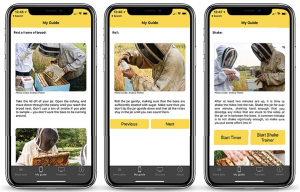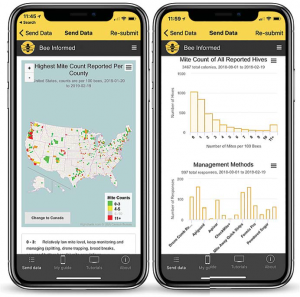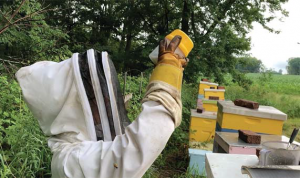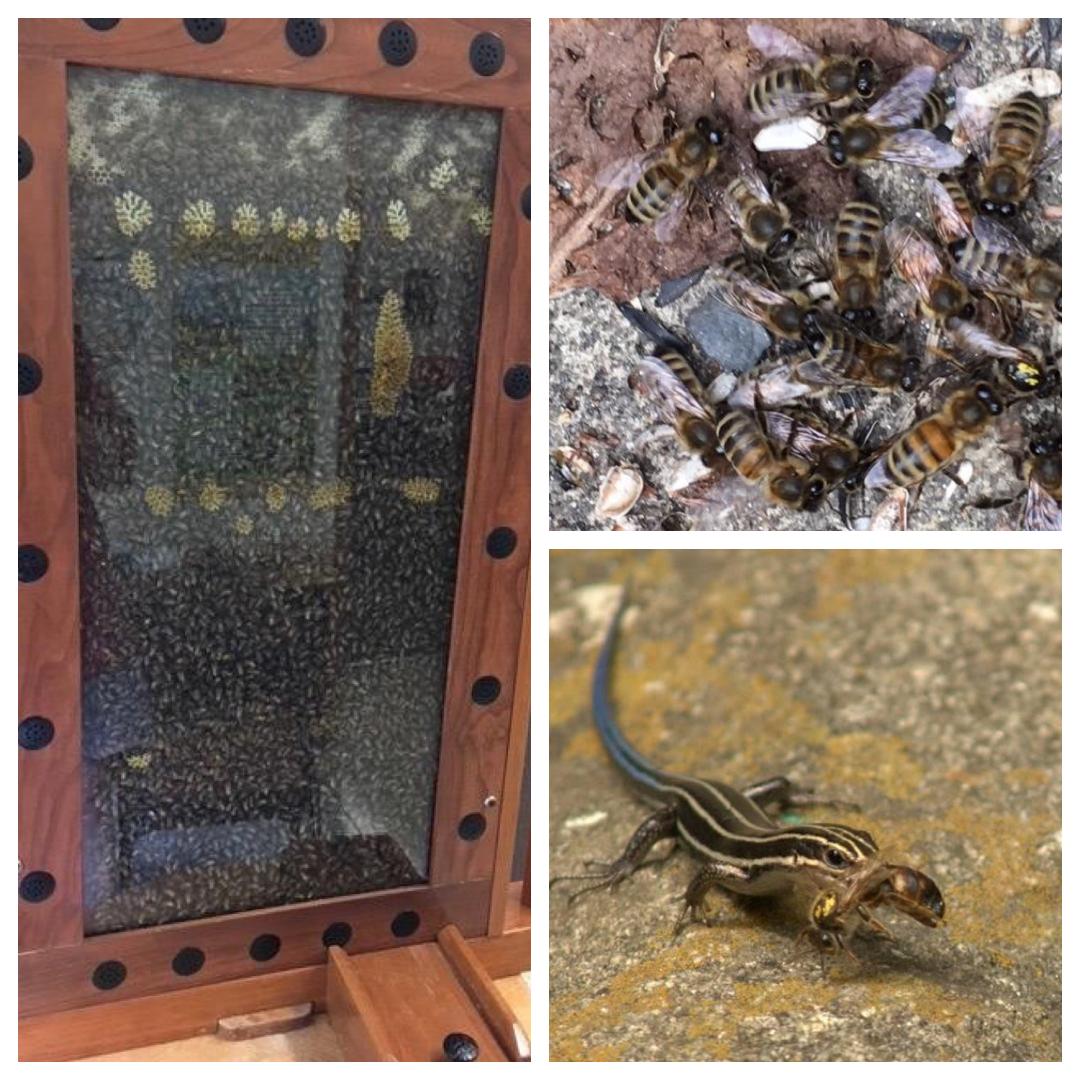By: Jonathan Engelsma (Grand Valley State Univ), Meghan Milbrath (MI State Univ), Karen Rennich (BIP), James Willkes (Appalachian State Univ)
 Early Spring is the time of year when beekeepers are inspecting their colonies after the long Winter months for the first time in the new beekeeping season. According to the Bee Informed Partnership’s annual survey, almost 31% of these colonies were lost during the Winter of 2017-20181. This high loss inevitably leads beekeepers to ask the question “why did my bees die?”. The most common cause for these crashing colonies is death by Varroa associated viruses2.
Early Spring is the time of year when beekeepers are inspecting their colonies after the long Winter months for the first time in the new beekeeping season. According to the Bee Informed Partnership’s annual survey, almost 31% of these colonies were lost during the Winter of 2017-20181. This high loss inevitably leads beekeepers to ask the question “why did my bees die?”. The most common cause for these crashing colonies is death by Varroa associated viruses2.
Properly monitoring and managing Varroa infestations in your colonies can reduce your colony losses yearround. However, recent data suggests that even colonies diligently managed for Varroa all Summer long are experiencing late season reinfestations3. Conventional thinking is that your healthy colonies are robbing out nearby crashing colonies and bringing home the mites from these dying hives. This suggests that monitoring and managing for Varroa mites in your own colonies, is not enough – you also need to be concerned about your neighbor’s mites! We think that last statement warrants repeating because of how serious this situation is – you now need to be concerned about your neighbor’s mites in addition to managing your own.
We would posit that what is needed is a coordinated response within the beekeeping community to the mite challenge. That is, an approach that involves each individual beekeeper responsibly monitoring and managing Varroa mites in their colonies, and doing so in a way that further encourages and facilitates awareness within the broader beekeeping community. This is exactly what the new MiteCheck mobile app sets out to do.
The MiteCheck mobile app is the fruit of an ongoing joint collaboration involving the Bee Informed Partnership, the University of Minnesota Bee Squad, and Michigan State University. The app, freely available on both the Apple iTunes App Store for iPhone users, and the Google Play Store for Android users has a three-fold mission:
- Educational tool: helps beekeepers learn how to properly monitor for Varroa mites.
- Data collection tool: make it easy for beekeepers to submit their mite counts, when monitoring their colonies, for research purposes.
- Community awareness tool: helps beekeepers stay abreast of current mite infestations levels in their area.
- Motivational tool: encourage beekeepers to monitor for and manage mites consistently over the beekeeping season.
In what follows, we will describe how the MiteCheck app can be used by beekeepers everywhere to help keep mites in check. However, don’t take our word for it – get a free copy of the app installed now on your smartphone and try it for yourself!
Educational Tool
There is an old adage, “experience is the best teacher, but the tuition is very expensive”. Many of our readers will readily concur that this is particularly true when it comes to managing mites in your honey bee colonies. Consider the following familiar scenario:
You’re a first-year beekeeper. It’s September. Your single colony in the backyard is still busting out with bees and plenty of honey stored, in addition to the bucketful in your pantry. You carefully do a visual on every frame. As far as you can tell, there is no obvious signs of mites or the mite-related damage you’ve been reading about on the Web. Everything seems to be just fi ne. No need to treat! Time to get online and share your beekeeping prowess with the rest of the world! Fast forward to a warm winter afternoon the following February, when you take a peek in your hive and fi nd only dead bees and a mouse nest. After a bit of research, the evidence is now clear – your colony crashed due to a mite infestation. Meanwhile, you feel like you just ran over your dog (and you aren’t even aware of the effect on your neighbor’s bees!). But it gets even worse. That evening, when you inform your spouse you need to shell out another $160 for replacement bees, your new hobby is nixed and instead, you’ll be growing organic tomatoes in the deck planter and mowing the lawn. Time to sell your bee equipment on Craigslist.
This is a very common scenario in beekeeping today. Not only is it discouraging new beekeepers from continuing on in their new-found hobby, it is also expensive and problematic for nearby beekeepers who are properly monitoring and managing mites within their colonies. Beginner beekeepers are constantly losing their bees to uncontrolled mite populations because they don’t know how to properly monitor for mites and their neighbors are put at risk by their crashing hives. Clearly, all beekeepers need to know how to monitor mite levels in their colony and intervene when treatment thresholds are reached. The MiteCheck app is designed to serve as an educational tool, teaching beekeepers how to properly monitor for mites.
At the moment, there are two commonly used procedures for determining mite infestation levels in colonies, the sugar roll and the alcohol wash. These techniques allow beekeepers to identify the level of infestation by dislodging the mites from a known quantity of bees. The “My Guide” areas of the app provides illustrated step by step guides for conducting either of these two mite monitoring procedures. A beekeeper can step through the screens one by one on their smartphone as they complete the procedure in the apiary.
The app has features that address the most common errors beekeepers make with these monitoring techniques. Failing to perform all the steps properly can yield overly optimistic results (e.g. you think your mite levels are lower than they actually are!) which is obviously a problem. The timer and the shake trainer feature are designed to help beekeepers learn to properly do the sugar roll and hopefully avoid these potential pitfalls. After depositing the bees in the shaker jar, and rolling them in powdered sugar, it is recommended to let the jar sit in the shade for two minutes. As the bees heat up, the mites fall off and the sugar prevents them from reattaching to the bees. Many beekeepers do not remember to let them sit for long enough, and If this step is not done properly, it’s possible that some of the mites in the sample will not be dislodged during the subsequent shake step, resulting in a falsely low count. The app has a built-in timer with an audible alert that can be armed when the two minutes reached, ensuring that sufficient time has passed to cause the mites to fall off.
A second potential issue when doing a sugar roll is not shaking the jar vigorously and long enough to completely dislodge all the mites. We often tell new beekeepers if their arm is not really tired after the shake step, they probably haven’t shaken hard enough. In order to help new beekeepers quickly develop a sense for how hard they need to shake, and the duration of the shake step, the app implements a “Shake Trainer”. Using the smart phone’s accelerometer (the same technology that causes your screen to auto rotate, when you reposition your phone from a portrait orientation to a landscape orientation), the app senses the speed and rigor of your shake motion and gives you corrective audible feedback such as “Shake harder”, “Shake faster”, or an encouraging “Good job” or “That’s it!” when you are shaking properly. As the simulated shake training session progresses towards the minute mark, the phone screen fades to an encouraging green color giving you visual feedback on your progress.
In addition to the sugar roll, the “My Guide” section of the app provides step by step instructions as well on how to do an alcohol wash. While not as popular among hobby beekeepers (it kills the sampled bees), the alcohol wash is actually easier to perform and more accurate. Our hope is that by including this information in the app, more beekeepers will adopt the alcohol wash for mite monitoring.
In addition to the step-by-step guides, the “Tutorial” section of the app provides a variety of professionally produced instructional videos on how to conduct a sugar roll or alcohol wash, as well as quick access to the shake trainer.
Data collection tool
The MiteCheck app is tapping into web-based technologies and the power of citizen scientist to help keep mites in check. The advent of the Internet and the World-Wide Web has significantly increased this so-called crowd sourcing of data capture in scientific inquiry. One of the strengths of the Web and the Internet in general is its ability to achieve massive scale. For example, it is reported Facebook had approximately 2.32 billion monthly active users as of December 31, 2018 [4]. Not many years ago, it was almost inconceivable that this many people could interact in a single application experience at this scale!

The MiteCheck app’s “My Guide” feature provides you with step-by-step instructions to complete a sugar roll or an alcohol wash.
Imagine a research project involving a handful of grant-funded bee researchers scattered across the USA trying to go out collect and accurately process a million or more bee samples from every county with at least one managed honey bee colony during a single beekeeping season. The project is doomed from the outset, since the scope of the data collection would far exceed the researchers’ capacity to collect and process data. MiteCheck app takes the citizen scientist approach to facilitate data collection at this immense scale. A recent survey indicates there are approximately 125,000 beekeepers in the U.S. If 10% of all beekeepers sampled an average of 10 colonies per month over an eight-month season, using standard procedures, and contributed their counts to a centralized database via the MiteCheck app, scientists could have data describing a million samples! We can identify regional and seasonal trends in disease risk and pest dynamics, data that are essential for getting ahead of this epidemic.
Establishing community awareness
Mite data collected at this scale and beyond can enable us to start better understanding and responding to mite infestations as a community.
A key enabler underlying a citizen scientist based project like MiteCheck, is the ability to efficiently collect quality data, just in time. This is exactly what the MiteCheck app is designed to do. Beekeepers can take their smart phones to the apiary with them, and submit their mite counts immediately, via an easy to use data entry form.
Under the “Send data” tab in the app, the beekeeper enters an email address (and optionally additional contact info) and can then proceed to enter their mite counts. Multiple counts can be entered in a single submission. The location is captured automatically via the device’s GPS receiver, but can be adjusted to either obfuscate apiary location, or support data entry after the beekeeper has left the vicinity of the apiary. Data is also captured on the sampling procedure used (sugar roll or alcohol wash) and date. Treatments used in the past two months can be included, as well as anticipated treatments.
We’ve worked hard to make the data entry procedure fun and easy. Within a minute or two most beekeepers should be able to submit the data for a half dozen or more samples. This coming bee season, we urge you to sample regularly, at least once a month. We also urge you to install MiteCheck and send in your mite counts.
The quality and actionability of the interactive heat map already provided by the MiteCheck app will be dramatically improved, and beekeepers everywhere can begin to receive real-time mite alerts and forecasts just like they receive weather information today.
Hence, if you sample a colony today, you’ll know whether or not intervention is required. However, if you sample a colony today and immediately report your counts via the MiteCheck app, you’ll be helping your neighbors keep mites in check as well, which ultimately is helping you in the long run.
Motivational Tool
Let’s revisit the beginning beekeeper scenario we shared earlier in this article, but play it back in a slightly different way, illustrating the functionality that can be supported in the future if everybody is monitoring their colonies for mites, and submitting their data using the MiteCheck app:

The MiteCheck heatmap, showing recently reported mite counts across the U.S. by county, and histograms of overall mite counts and management methods.
It’s early the third week of July. You’re a fi rstyear beekeeper, and your bees are doing great. You have three full honey supers, and can’t wait to harvest it. However, your bees are far from your mind right now, as you are enjoying a cold one at the camp fire with a few friends. Suddenly you get a “code red” notifi cation on your iPhone from that MiteCheck app thingy they told you to install at the bee school you attended back in February. You swipe open the notifi cation, and are informed that multiple apiaries within 10 miles of your own have reported mite infestations at or exceeding three mites per 100 bees within the last 24 hours. You make a mental note of this and fi nish off another cold one.
The next morning is Saturday, and you’re not about to let these mites get the upper hand in your apiary! However, you don’t quite remember the procedure they taught for mite monitoring at the bee school, so you pull up MiteCheck and watch a couple of tutorial videos over breakfast. After breakfast, you gather your gear and head out to your backyard apiary. You use the “My guide” in MiteCheck to guide you through an alcohol wash, and sure enough, you’re at three mites per 100! You submit your count via the app and then proceed to remove the honey supers and apply a treatment. In late August you get another reminder from the app to do a post treatment count. You comply and discover you are well under threshold. Great, the treatment was effective, and you simply submit the data in MiteCheck! Late September, you receive another “code red” alert from MiteCheck warning you that nearby apiaries are once again at threshold. However, you simply dismiss it. You’re dialed into the mites now, and actually proactively checked and treated again a few days earlier!
Fast forward to a warm Winter afternoon the following February, you approach the hive and see plenty of activity at the entrance as the bees take their cleansing flights. You gently pry open the cover and as the delightful smell of a healthy beehive greets you, you notice immediately the box is bursting with bees! They are starting to brood up now, and it won’t be long now and you’ll be out there splitting it! You realize you’re soon going to have more bees than you have boxes, and make a mental note to have that conversation with your spouse about increasing the bee budget. This time you’re pretty confident it’s not going to be an issue.
What we’ve described here is realistic and achievable in the near future if we all work together on the mite challenge. We hope you’ll join our project and become a citizen scientist by installing the MiteCheck app on your smartphone, monitoring for and managing mites regularly, and of course submitting your mite count data via MiteCheck. Together we can keep mites in check!
Acknowledgements
We’d like to thank our fellow collaborators who have helped make the MiteCheck app a reality: Nicolas Arias, Rebecca Masterman, Santiago Quiroga and Michael Wilson.
References
Beeinformed.org. (2018). Honey Bee Colony Losses 2017- 2018: Preliminary Results|Bee Informed Partnership. [online] Available at: https://beeinformed.org/ results/honey-bee-colony-losses-2017-2018- preliminary-results/ [Accessed 8 Feb. 2019].
Milbrath, M. (2018). Why did my honey bees die? [online] Beeinformed.org. Available at: https://beeinformed. org/2016/03/08/why-did-my-honey-bees-die/ [Accessed 8 Feb. 2019].
Degrandi-Hoffman, Gloria et al. “Population growth of Varroa destructor (Acari: Varroidae) in honey bee colonies is affected by the number of foragers with mites.” Experimental and Applied Acarology (2016). https://doi.org/10.1007/s10493-016-0022-9 [Accessed 21 Mar. 2019].
Zephoria.com. (2019). The Top 20 Valuable Facebook Statistics – Updated January 2019. [online] Available at: https://zephoria.com/top-15-valuable-facebookstatistics/ [Accessed 8 Feb. 2019]









